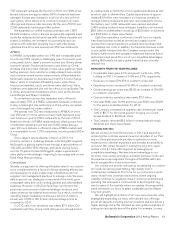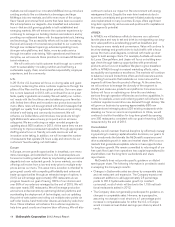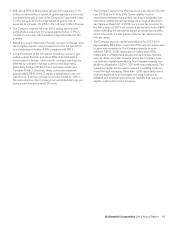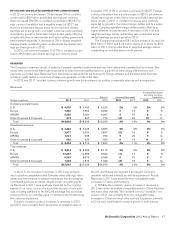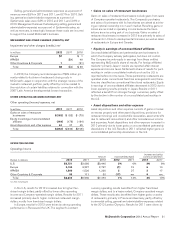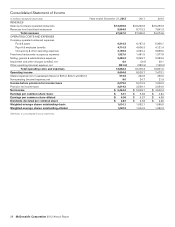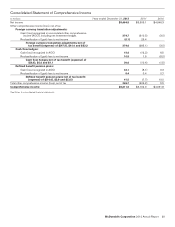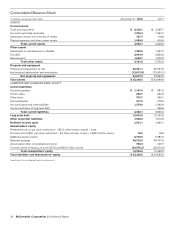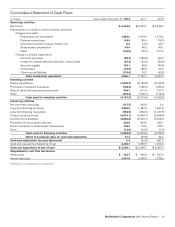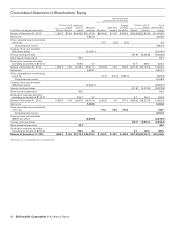McDonalds 2012 Annual Report Download - page 24
Download and view the complete annual report
Please find page 24 of the 2012 McDonalds annual report below. You can navigate through the pages in the report by either clicking on the pages listed below, or by using the keyword search tool below to find specific information within the annual report.
stronger operating performance in France, the U.K., Russia and
Germany, and higher combined restaurant margin dollars, primar-
ily franchised margin dollars.
In APMEA, results for 2012 increased primarily due to higher
franchised margin dollars and gains on sales of restaurants in
China to developmental licensees, partly offset by lower
Company-operated margin dollars and lower operating results in
Japan. Results for 2011 increased due to stronger operating
results in many markets. Impairment charges in 2010 also pos-
itively impacted the constant currency growth rate for 2011 by 4
percentage points.
• Combined operating margin
Combined operating margin is defined as operating income as a
percent of total revenues. Combined operating margin for 2012,
2011 and 2010 was 31.2%, 31.6% and 31.0%, respectively.
INTEREST EXPENSE
Interest expense increased 5% and 9% in 2012 and 2011,
respectively, primarily due to higher average debt balances, partly
offset by lower average interest rates. Stronger foreign curren-
cies also contributed to the increase in 2011.
NONOPERATING (INCOME) EXPENSE, NET
Nonoperating (income) expense, net
In millions 2012 2011 2010
Interest income $(28) $(39) $(20)
Foreign currency and hedging activity 99 (2)
Other expense 28 55 44
Total $9 $25 $22
Interest income consists primarily of interest earned on short-
term cash investments. Foreign currency and hedging activity
includes net gains or losses on certain hedges that reduce the
exposure to variability on certain intercompany foreign currency
cash flow streams.
PROVISION FOR INCOME TAXES
In 2012, 2011 and 2010, the reported effective income tax rates
were 32.4%, 31.3% and 29.3%, respectively.
In 2012, the effective income tax rate reflected the negative
impact of certain tax benefits in the U.S. that had expired at
December 31, 2011. In January 2013, the United States enacted
the American Taxpayer Relief Act of 2012 (“Act”). The Act
reinstated, retroactive to January 1, 2012, certain tax benefits
that had previously expired. However, in accordance with the
financial accounting standards for income taxes, the Company is
required to account for the effects of changes in tax laws in the
period the legislation is enacted.
In 2011, the effective income tax rate reflected lower tax
benefits related to certain foreign tax credits, partially offset by
nonrecurring deferred tax benefits related to certain foreign
operations.
Consolidated net deferred tax liabilities included tax assets,
net of valuation allowance, of $1.5 billion in 2012 and 2011.
Substantially all of the net tax assets are expected to be realized
in the U.S. and other profitable markets.
ACCOUNTING CHANGES
• Fair value measurements
In May 2011, the Financial Accounting Standards Board
(“FASB”) issued an update to Topic 820 – Fair Value Measure-
ment of the Accounting Standards Codification (“ASC”). This
update provides guidance on how fair value accounting should be
applied where its use is already required or permitted by other
standards and does not extend the use of fair value accounting.
The Company adopted this guidance effective January 1, 2012,
as required, and it did not have a significant impact on its con-
solidated financial statements.
• Comprehensive Income
In June 2011, the FASB issued an update to Topic 220 – Com-
prehensive Income of the ASC. The update is intended to
increase the prominence of other comprehensive income in the
financial statements. The guidance requires that the Company
presents components of comprehensive income in either one
continuous statement or two separate consecutive statements.
The Company adopted this new guidance in 2012, as required,
and included a separate Consolidated statement of compre-
hensive income in the consolidated financial statements
appearing elsewhere herein.
Cash Flows
The Company generates significant cash from its operations and
has substantial credit availability and capacity to fund operating
and discretionary spending such as capital expenditures, debt
repayments, dividends and share repurchases.
Cash provided by operations totaled $7.0 billion and
exceeded capital expenditures by $3.9 billion in 2012, while cash
provided by operations totaled $7.2 billion and exceeded capital
expenditures by $4.4 billion in 2011. In 2012, cash provided by
operations decreased $184 million or 3% compared with 2011
despite increased operating results, primarily due to higher
income tax payments and the negative impact of foreign currency
translation on operating results. In 2011, cash provided by oper-
ations increased $808 million or 13% compared with 2010
primarily due to higher operating results.
Cash used for investing activities totaled $3.2 billion in 2012,
an increase of $596 million compared with 2011. The increase
primarily reflected higher capital expenditures, an increase in
other investing activities related to short-term time deposits, and
lower proceeds from sales of restaurant businesses. Cash used
for investing activities totaled $2.6 billion in 2011, an increase of
$515 million compared with 2010. This reflected higher capital
expenditures, partly offset by higher proceeds from sales of res-
taurant businesses.
Cash used for financing activities totaled $3.8 billion in 2012,
a decrease of $683 million compared with 2011, primarily due to
lower treasury stock purchases and higher net debt issuances,
partly offset by higher dividend payments. Cash used for financ-
ing activities totaled $4.5 billion in 2011, an increase of $804
million compared with 2010, primarily due to higher treasury
stock purchases, higher dividend payments and lower proceeds
from stock option exercises, partly offset by higher net debt issu-
ances.
The Company’s cash and equivalents balance was $2.3 billion
at year end 2012 and 2011. In addition to cash and equivalents
22 McDonald’s Corporation 2012 Annual Report



